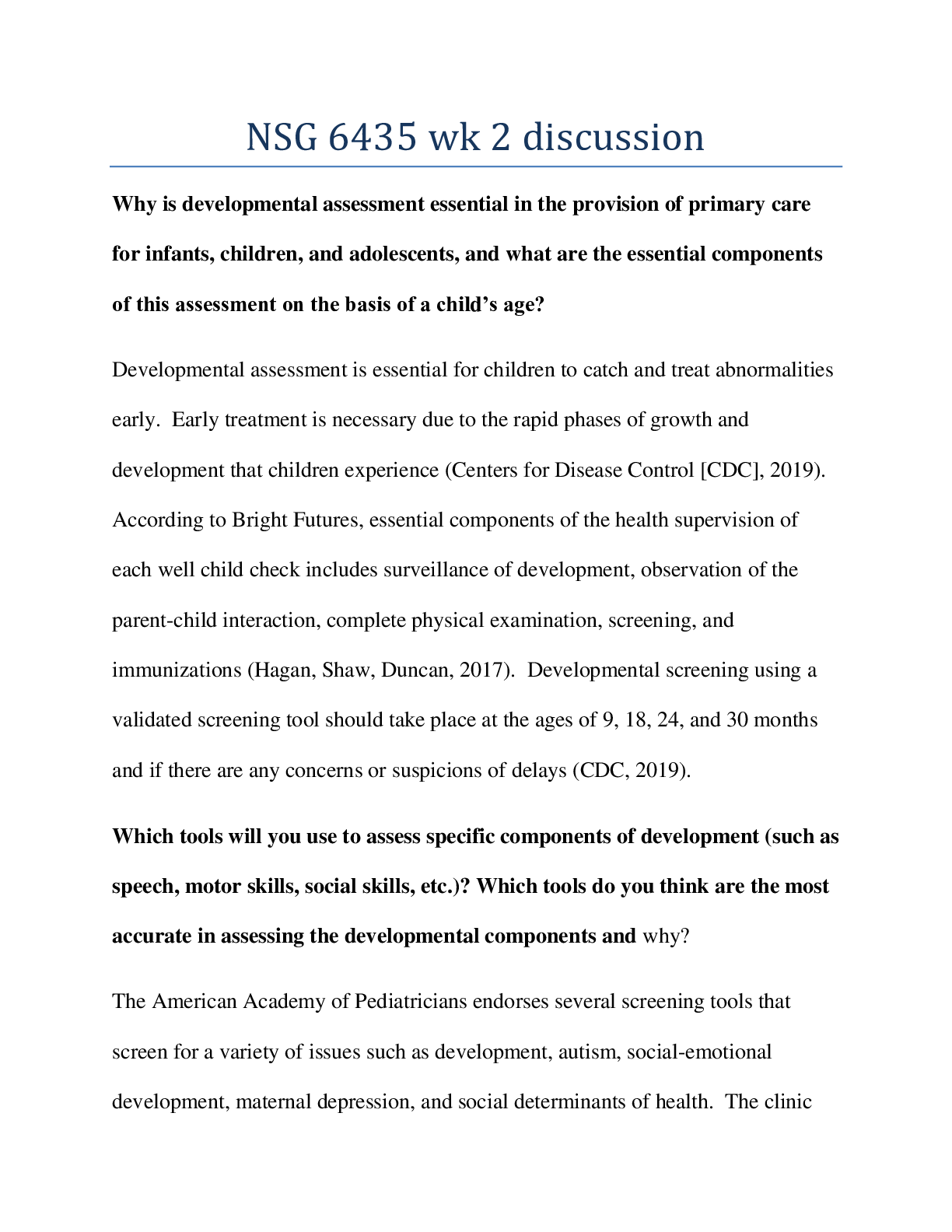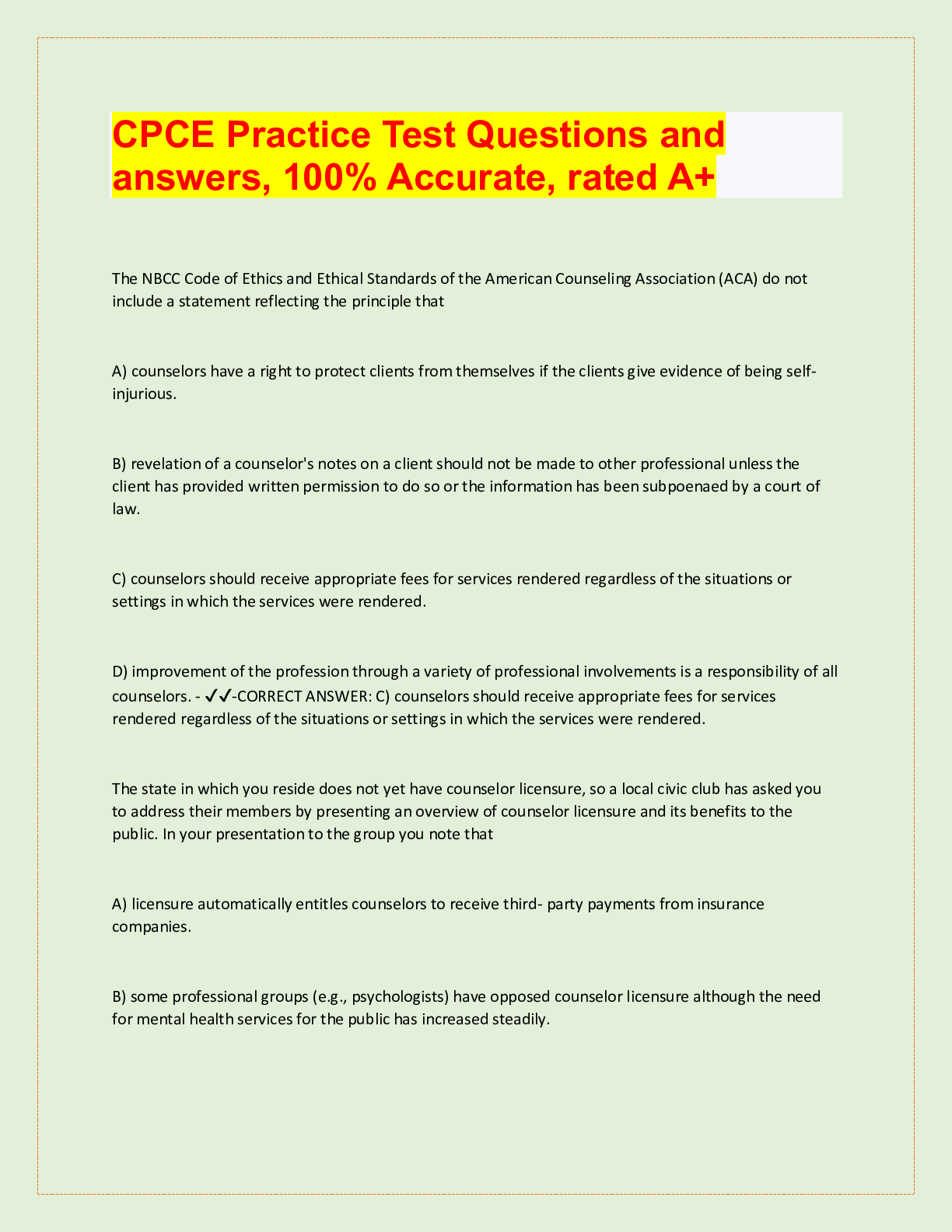Chemistry > QUESTIONS & ANSWERS > Sunny Hills High BIO 420Elizabeth Kim - Unit 6 Review_ Gene Expression and Regulation. TOPIC 6.1 DNA (All)
Sunny Hills High BIO 420Elizabeth Kim - Unit 6 Review_ Gene Expression and Regulation. TOPIC 6.1 DNA and RNA Structure. Questions and Answers
Document Content and Description Below
Unit 6: Gene Expression and Regulation TOPIC 6.1 DNA and RNA Structure © Science of Curiosity ENDURING UNDERSTANDING IST-1Heritable information provides for continuity of life. LEARNING OBJECTIVE... IST-1.KDescribe the structures involved in passing hereditary information from one generation to the next. ESSENTIAL KNOWLEDGE IST-1.K.1DNA, and in some cases RNA, is the primary source of heritable information. IST-1.K.2Genetic information is transmitted from one generation to the next through DNA or RNA— a. Genetic information is stored in and passed to subsequent generations through DNA molecules and, in some cases, RNA molecules. b. Prokaryotic organisms typically have circular chromosomes, while eukaryotic organisms typically have multiple linear chromosomes. IST-1.K.3Prokaryotes and eukaryotes can contain plasmids, which are small extra-chromosomal, double-stranded, circular DNA | What is the significance of this famous experiment (what does it demonstrate)? How did Crick, Watson, Franklin and Wilkins contribute to our knowledge of DNA? Draw a plasmid. Where are plasmids found in Prokaryotic cells? Where are they found in Eukaryotic cells (HINT consider the evolution of some Eukaryotic organelles!)? Come up with some way to remember (to link the facts together) that A and G are Purines and have a double ring, while C, T, and U are Pyrimidines and have just one ring. Then share your idea with someone and see what idea they came up with! © Science of Curiosity molecules. LEARNING OBJECTIVE IST-1.LDescribe the characteristics of DNA that allow it to be used as the hereditary material. ESSENTIAL KNOWLEDGE IST-1.L.1DNA, and sometimes RNA, exhibits specific nucleotide base pairing that is conserved through evolution: adenine pairs with thymine or uracil (A-T or A-U) and cytosine pairs with guanine (C-G)— a. Purines (G and A) have a double ring structure. b. Pyrimidines (C, T, and U) have a single ring structure. | Briefly explain in your own words how the base pairing rules of DNA lead to its ability to be used as the hereditary material of life (aka, to be copied and passed to a resulting daughter cell). A always matches with T, and G always matches with C…..but why? Proofreading enzymes run along the DNA molecule to be sure there are no mis-pairings between bases, but how do they know when a mistake has happened? Based on their structure (shape) explain why purines must always match with pyrimidines. In your explanation, include how a proofreading enzyme would identify a location where two purines are accidentally matched up, and a location where two pyrimidines are matched up. Okay, but why can't T (a pyrimidine) match with G (a purine)? Based on the number of hydrogen bonds that are available in adenine, thymine, guanine and cytosine, explain why A always matches with T, and C with G. In your explanation, include how a proofreading enzyme would identify a location where G and T are accidentally matched up, and a location where A and C are matched up. Unit 6: Gene Expression and Regulation TOPIC 6.2 Replication © Science of Curiosity ENDURING UNDERSTANDING IST-1Heritable information provides for continuity of life LEARNING OBJECTIVE IST-1.MDescribe the mechanisms by which genetic information is copied for transmission between generations. ESSENTIAL KNOWLEDGE IST-1.M.1DNA replication ensures continuity of hereditary information— a. DNA is synthesized in the 5’ to 3’ direction. b. Replication is a semiconservative process—that is, one strand of DNA serves as the template for a new strand of complementary DNA. c. Helicase unwinds the DNA strands. d. Topoisomerase relaxes supercoiling in front of the replication fork. e. DNA polymerase requires RNA primers to initiate DNA synthesis. f. DNA polymerase synthesizes new strands of DNA continuously on the leading strand and discontinuously on the lagging strand. g. Ligase joins the fragments on the lagging strand. X The names of the steps and particular enzymes involved - beyond DNA polymerase, ligase, RNA polymerase, helicase, and topoisomerase - are beyond the scope of the AP Exam | In your own words, what does it mean that DNA replication is a ‘semiconservative’ process? Draw each of the following enzymes into the diagram where they would be working during DNA Replication. See the standards on the left for a description of their role. On diagram, label the leading strand and the lagging strand - briefly explain why Replication works a bit differently on the leading vs. lagging strand. Use the word antiparallel Helicase Ligase (will need two) DNA polymerase (will need two) Topoisomerase Unit 6: Gene Expression and Regulation TOPIC 6.3 Transcription and RNA Processing © Science of Curiosity ENDURING UNDERSTANDINGIST-1 Heritable information provides for continuity of life. LEARNING OBJECTIVE IST-1.NDescribe the mechanisms by which genetic information flows from DNA to RNA to protein. ESSENTIAL KNOWLEDGE IST-1.N.1The sequence of the RNA bases, together with the structure of the RNA molecule, determines RNA function— a. mRNA molecules carry information from DNA to the ribosome. b. Distinct tRNA molecules bind specific amino acids and have anti-codon sequences that base pair with the mRNA. tRNA is recruited to the ribosome during translation to generate the primary peptide sequence based on the mRNA sequence. c. rRNA molecules are functional building blocks of ribosomes. IST-1.N.2Genetic information flows from a sequence of nucleotides in DNA to a sequence of bases in an mRNA molecule to a sequence of amino acids in a protein. IST-1.N.3RNA polymerases use a single template strand of DNA to direct the inclusion of bases in the newly formed RNA molecule. This process is known as transcription. | What is the ‘Central Dogma’ of Biology? ______ >> ________ >> _____________ In your own words, describe the job of each type of RNA, using the given word… ● mRNA use the word ‘message’ ● tRNA use the word ‘transfer’ ● rRNA use the word ‘ribosome’ Find the location that an RNA polymerase would begin transcription - draw a circle around the start codon (TAC) and an arrow showing the direction the RNA polymerase would travel as it reads the DNA.*remember RNA-polymerase reads the DNA molecule in the 3’ to 5’ direction 5’ TGACCAAAGATTGCATCCTGATTTCCTA 3’ 3’ ACTGGTTTCTAACGTAGGACTAAAGGAT 5’ Put a star beside the antisense strand. Why would this strand (that is used as a template for RNA Polymerase) be called the antisense, or noncoding strand? Explain. © Science of Curiosity IST-1.N.4 The DNA strand acting as the template strand is also referred to as the noncoding strand, minus strand, or antisense strand. Selection of which DNA strand serves as the template strand depends on the gene being transcribed. IST-1.N.5The enzyme RNA polymerase synthesizes mRNA molecules in the 5’ to 3’ direction by reading the template DNA strand in the 3’ to 5’ direction. IST-1.N.6In eukaryotic cells the mRNA transcript undergoes a series of enzyme-regulated modifications— a. Addition of a poly-A tail. b. Addition of a GTP cap. c. Excision of introns and splicing and retention of exons. d. Excision of introns and splicing and retention of exons can generate different versions of the resulting mRNA molecule; this is known as alternative splicing. | What is the purpose of the poly-A tail and the GTP cap? During mRNA processing, introns must be removed from between the exons (protein coding regions). Draw a strand of pre-mRNA with introns - then ‘x-out’ the introns so show they must be removed. How can you remember that it is the exons that stay and the introns that must be removed during mRNA processing? Come up with a creative way to remember and share it with someone else. You have roughly 20,000 genes in your genome - but the ability to produce over 2 million different proteins! How is this possible? (HINT read standard IST-1N6d) Unit 6: Gene Expression and Regulation TOPIC 6.4 Translation © Science of Curiosity ENDURING UNDERSTANDINGIST-1 Heritable information provides for continuity of life. LEARNING OBJECTIVE IST-1.O Describe how the phenotype of an organism is determined by its genotype. ESSENTIAL KNOWLEDGE IST-1.O.1 Translation of the mRNA to generate a polypeptide occurs on ribosomes that are present in the cytoplasm of both prokaryotic and eukaryotic cells and on the rough endoplasmic reticulum of eukaryotic cells. IST-1.O.2In prokaryotic organisms, translation of the mRNA molecule occurs while it is being transcribed. IST-1.O.3Translation involves energy and many sequential steps, including initiation, elongation, and termination X The details and names of the enzymes and factors involved in each of these steps are beyond the scope of the AP Exam IST-1.O.4The salient features of translation include— a. Translation is initiated when the rRNA in the ribosome interacts with the mRNA at the start codon. b. The sequence of nucleotides on the mRNA is read in triplets called codons. | Explain why transcription and translation can happen at the same time in Prokaryotes, but not in Eukaryotic cells. Briefly describe what happens in each stage of translation. Include the roles of rRNA, mRNA, tRNA, codons, anticodons, and amino acids. Draw a line between each codon. Then use the Codon Chart on the next page to translate this mRNA sequence into amino acids. A - U - G - G - A - A - C - A - G - G - U - A - A - G - A Re-write the mRNA sequence with one point mutation that would still lead to the same amino acid sequence. Put a line between the codons. Underline your point mutation. initiation elongation termination © Science of Curiosity c. Each codon encodes a specific amino acid, which can be deduced by using a genetic code chart. Many amino acids are encoded by more than one codon. d. Nearly all living organisms use the same genetic code, which is evidence for the common ancestry of all living organisms. e. tRNA brings the correct amino acid to the correct place specified by the codon on the mRNA. f. The amino acid is transferred to the growing polypeptide chain. g. The process continues along the mRNA until a stop codon is reached. h. The process terminates by release of the newly synthesized polypeptide/protein. X Memorization of the genetic code is beyond the scope of the AP Exam IST-1.O.5Genetic information in retroviruses is a special case and has an alternate flow of information: from RNA to DNA, made possible by reverse transcriptase, an enzyme that copies the viral RNA genome into DNA. This DNA integrates into the host genome and becomes transcribed and translated for the assembly of new viral progeny. X The names of the steps and particular enzymes involved—beyond DNA polymerase, ligase, RNA polymerase, helicase, and topoisomerase—are beyond the scope of the course and the AP Exam. | You can get the polio vaccine one time and be immune for life, but you must take a flu vaccine each year to be immune for just that season. This is because the flu (and HIV as well) are retroviruses. How are retroviruses different from other viruses? How does this difference lead to the need to get a flu shot every year? Unit 6: Gene Expression and Regulation TOPIC 6.5 Regulation of Gene Expression © Science of Curiosity ENDURING UNDERSTANDING IST-2Differences in the expression of genes account for some of the phenotypic differences between organisms. LEARNING OBJECTIVE IST-2.ADescribe the types of interactions that regulate gene expression. ESSENTIAL KNOWLEDGE IST-2.A.1Regulatory sequences are stretches of DNA that interact with regulatory proteins to control transcription. IST-2.A.2Epigenetic changes can affect gene expression through reversible modifications of DNA or histones. IST-2.A.3The phenotype of a cell or organism is determined by the combination of genes that are expressed and the levels at which they are expressed— a. Observable cell differentiation results from the expression of genes for tissue specific proteins. b. Induction of transcription factors during development results in sequential gene expression LEARNING OBJECTIVE | Regulatory sequencesof DNA do not code for a protein. What is their purpose? A scientist has noted the gene expression of a group of cells. Read the unique gene that is expressed and determine what type of cell it must be. What are histones? What is the role of histones in regulating gene expression? This is a histone - draw a strand of DNA wrapped around the histone. What leads to cell differentiation during development? Use the word transcription factors in your answer. Why is it beneficial for cells of a multicellular organism to be able to regulate their gene expression? Why is it beneficial for single cellular organisms to be able to regulate their gene expression? Achedocholine Hemoglobin Actin and myosin Antibodies Insulin © Science of Curiosity IST-2.B Explain how the location of regulatory sequences relates to their function. ESSENTIAL KNOWLEDGE IST-2.B.1Both prokaryotes and eukaryotes have groups of genes that are coordinately regulated— a. In prokaryotes, groups of genes called operons are transcribed in a single mRNA molecule. The lac operon is an example of an inducible system b. In eukaryotes, groups of genes may be influenced by the same transcription factors to coordinately regulate expression. | This is the lac operon of prokaryotic cells. What does it code for? What does each of these numbers represent in the diagram of the lac operon? 1: 2: 3: 4: 5 : 6 - 8: The lac operon is an INDUCIBLE operon. What does this mean? How does the operon turn on? (be specific to the lac operon). What would happen if there was a mutation in the regulatory gene for the lac operon so that the regulatory protein did not bind to the operator? What would happen if there was a mutation in the regulatory gene for the lac operon so that the regulatory protein did not bind to lactose sugar? Unit 6: Gene Expression and Regulation TOPIC 6.6 Gene Expression and Cell Specialization © Science of Curiosity ENDURING UNDERSTANDING IST-2 Differences in the expression of genes account for some of the phenotypic differences between organisms. LEARNING OBJECTIVE IST-2.CExplain how the binding of transcription factors to promoter regions affects gene expression and/or the phenotype of the organism. ESSENTIAL KNOWLEDGE IST-2.C.1Promoters are DNA sequences upstream of the transcription start site where RNA polymerase and transcription factors bind to initiate transcription. IST-2.C.2Negative regulatory molecules inhibit gene expression by binding to DNA and blocking transcription. LEARNING OBJECTIVE IST-2.DExplain the connection between the regulation of gene expression and phenotypic differences in cells and organisms. ESSENTIAL KNOWLEDGE IST-2.D.1Gene regulation results in differential gene expression and influences cell products and function. IST-2.D.2 Certain small RNA molecules have roles in regulating gene expression. | The promoter region of Gene A has a mutation such that the necessary transcription factor does not bind to it. This transcription factor turns on the gene. What does this mean for the production of Protein A? Explain. There is a mutation in the regulatory gene that turns off Gene B, such that the regulatory protein does not bind to the DNA. What does this mean for the production of Protein B? Explain. Cell Specialization is the process ofstem cells becoming… What is the difference between a muscle cell and a nerve cell? Use the words Tissue Specific, Differentiation, Gene Expression, and Proteins in your answer. Define microRNA: What does microRNA do? On the diagram, label where transcription factors work, and where microRNA (RNAi) works to regulate gene expression. Unit 6: Gene Expression and Regulation TOPIC 6.7 Mutations © Science of Curiosity ENDURING UNDERSTANDING IST-2Differences in the expression of genes account for some of the phenotypic differences between organisms. LEARNING OBJECTIVE IST-2.EDescribe the various types of mutation. ESSENTIAL KNOWLEDGE IST-2.E.1 Changes in genotype can result in changes in phenotype— a. The function and amount of gene products determine the phenotype of organisms. ● The normal function of the genes and gene products collectively comprises the normal function of organisms. ● Disruptions in genes and gene products cause new phenotypes. IST-2.E.2Alterations in a DNA sequence can lead to changes in the type or amount of the protein produced and the consequent phenotype. DNA mutations can be positive, negative, or neutral based on the effect or the lack of effect they have on the resulting nucleic acid or protein and the phenotypes that are conferred by the protein ILLUSTRATIVE EXAMPLES § Mutations in the CFTR gene disrupt ion transport and result in cystic fibrosis. § Mutations in the MC1R gene give adaptive melanism in pocket mice. | Genotype is: Phenotype is: Here is a normal sequence of mRNA. Use a Codon Chart to transcribe and translate it into its amino acid sequence (this is the same sequence in 6.4) A - U - G - G - A - A - C - A - G - G - U - A - A - G - A Now re-write the mRNA sequence with one point mutation that would be neutral to the organism with this sequence (recognize this point mutation is a reflection of a point mutation that would be in the DNA, transcribed here into mRNA). Translate your mutated sequence. Why is this mutation neutral? Now re-write the mRNA sequence with a point mutation that COULD be positiveto the organism with this sequence. Translate the mutated sequence into amino acids. Why might this be a positive mutation? © Science of Curiosity ENDURING UNDERSTANDINGIST-4 The processing of genetic information is imperfect and is a source of genetic variation LEARNING OBJECTIVE IST-4.AExplain how changes in genotype may result in changes in phenotype. ESSENTIAL KNOWLEDGE IST-4.A.1 Errors in DNA replication or DNA repair mechanisms, and external factors, including radiation and reactive chemicals, can cause random mutations in the DNA— a. Whether a mutation is detrimental, beneficial, or neutral depends on the environmental context. b. Mutations are the primary source of genetic variation. IST-4.A.2Errors in mitosis or meiosis can result in changes in phenotype— a. Changes in chromosome number often result in new phenotypes, including sterility caused by triploidy, and increased vigor of other polyploids. b. Changes in chromosome number often result in human disorders with developmental limitations, including Down syndrome/ Trisomy 21 and Turner syndrome. ILLUSTRATIVE EXAMPLES § Antibiotic resistance mutations § Pesticide | A wild rabbit is born with a mutation that causes his fur to be white. Describe an environment where this mutation would be negative (detrimental). Describe an environment where this mutation would be positive (beneficial). Describe an environment where this mutation would be neutral. The sickle cell gene is a result of a single base pair mutation. It is a recessive trait that can lead to a shortened life-span for people who are homozygous- however in some areas of Africa there is a very high incidence of Sickle Cell disease. Why is this? Use the words natural selectionand heterozygote advantagein your explanation. In the box, draw a punnett square showing the resulting offspring of two heterozygous individuals for the sickle cell trait. Percent of offspring have Sickle Cell disease _________ Percent of offspring susceptible to malaria _________ © Science of Curiosity resistance mutations § Sickle cell disorder and heterozygote advantage LEARNING OBJECTIVE IST-4.B Explain how alterations in DNA sequences contribute to variation that can be subject to natural selection. ESSENTIAL KNOWLEDGE IST-4.B.1Changes in genotype may affect phenotypes that are subject to natural selection. Genetic changes that enhance survival and reproduction can be selected for by environmental conditions— a. The horizontal acquisitions of genetic information primarily in prokaryotes via transformation (uptake of naked DNA), transduction (viral transmission of genetic information), conjugation (cell-to-cell transfer of DNA) and transposition (movement of DNA segments within and between DNA molecules) increase variation. b. Related viruses can combine/recombine genetic information if they infect the same host cell. c. Reproduction processes that increase genetic variation are evolutionarily conserved and are shared by various organisms. | Percent of offspring that do not have Sickle Cell and are not susceptible to malaria _______ Draw a simple diagram showing each way prokaryotes increase genetic variety. Then come up with a way to remember each one - somehow link the word with the process! In general, most species on the planet have some way of increasing genetic variation, and all species are susceptible to random mutation. Why is genetic variation shared across all species? What is the advantage to genetic variation? Drawing of Process Link the word to what it means Transformation Transduction Conjugation Unit 6: Gene Expression and Regulation TOPIC 6.8 Biotechnology © Science of Curiosity ENDURING UNDERSTANDINGIST-1Heritable information provides for continuity of life LEARNING OBJECTIVE IST-1.PExplain the use of genetic engineering techniques in analyzing or manipulating DNA. ESSENTIAL KNOWLEDGE IST-1.P.1Genetic engineering techniques can be used to analyze and manipulate DNA and RNA— a. Electrophoresis separates molecules according to size and charge. b. During polymerase chain reaction (PCR), DNA fragments are amplified c. Bacterial transformation introduces DNA into bacterial cells. d. DNA sequencing determines the order of nucleotides in a DNA molecule. X The details of these processes are beyond the scope of this course. The focus should be on the conceptual understanding of the application of these techniques | To the right is a gel plate for an Electrophoresis machine. You have a sample of DNA that you want to run through the gel. You will first cut the DNA sample into small pieces. What tool will you use to do this? (type of enzyme) Then you must make many many copies of the DNA sample. What process will you use to do this? You now have millions of copies of three DNA fragments. One fragment is 80 base pairslong, one fragment is 300 base pairslong, and one fragment is 200 base pairs long. Draw the relative location of the three fragments (and label them) in the gel. Explain: What causes the DNA molecules to move through the gel? How does the gel separate the pieces by size? Name two reasons that a scientist might use an Electrophoresis machine. © Science of Curiosity ILLUSTRATIVE EXAMPLES § Amplified DNA fragments can be used to identify organisms and perform phylogenetic analyses. § Analysis of DNA can be used for forensic identification. § Genetically modified organisms include transgenic animals. § Gene cloning allows propagation of DNA fragments. | Explain or draw the steps showing how pharmaceutical companies can use bacterial transformation to make human proteins (like insulin). What does the word ‘transgenic’ literally mean (its word parts) ____________ _____________ Around 90% of the processed food sold in the United States contains Genetically Modified ingredients. Name two types of plants that have been genetically modified, what new trait they now have, and why it was developed (what is the benefit). Do you think GMO foods should be labeled in the store? Why or why not?1. 2. [Show More]
Last updated: 1 year ago
Preview 1 out of 16 pages

Reviews( 2 )

by Steve Rundown · 2 years ago
Thank you and Happy Studying.. by QuizMaster. 2 years ago

by QuizMaster · 2 years ago
Document information
Connected school, study & course
About the document
Uploaded On
Apr 27, 2021
Number of pages
16
Written in
Additional information
This document has been written for:
Uploaded
Apr 27, 2021
Downloads
1
Views
115













.png)







.png)
.png)
.png)

.png)


.png)
.png)
.png)







